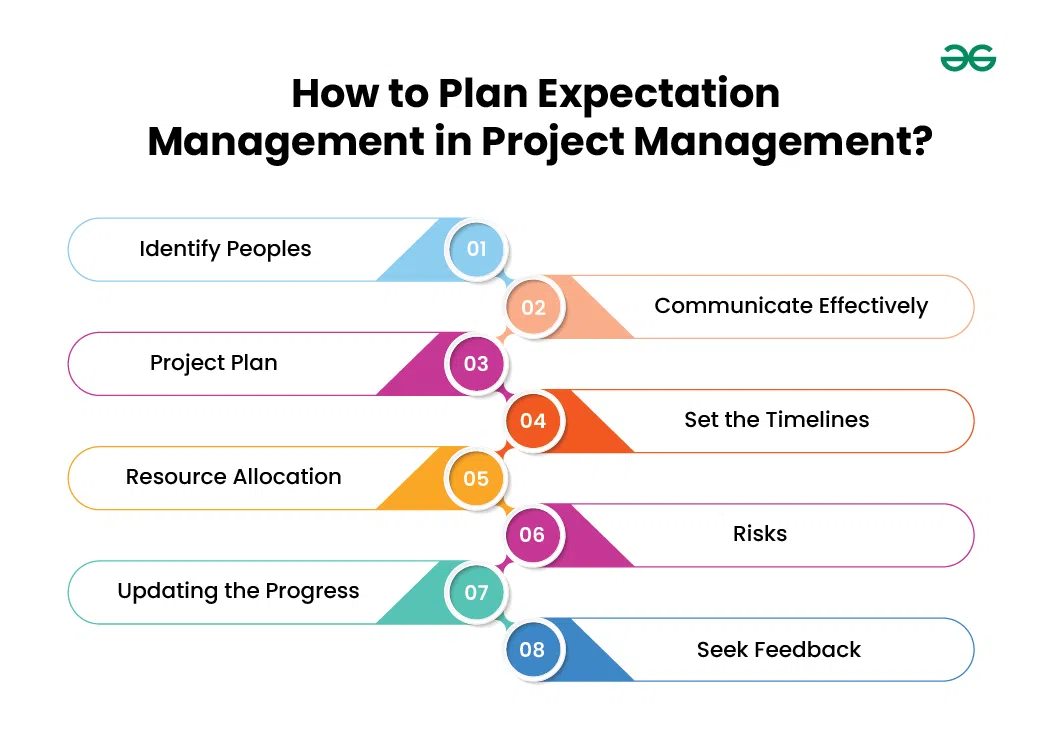How to Plan Expectation Management in Project Management?
Last Updated :
09 Apr, 2024
Planning expectation management in project management is about setting the project goals, making a plan to execute the project, making a budget plan for resources, and executing the plan. Establishing communication with team members, stakeholders, and clients reduces misunderstandings. Update the project progress to the stakeholders and take feedback from them regularly. So that, in case any delay occurs in the project, the stakeholders understand our situation.
What is Expectation Management in Project Management?
Expectation Management in Project management is making expectations about how much cost the resources will be, how much time the project will take, and whether the project will reach the expectations of stakeholders or not.
- Defining the project scope, setting goals, and establishing communication involve everyone in the project and ensure that everyone is together throughout the project.
- Also, We have to identify the risks that will occur in the project and find the appropriate solutions to avoid those risks.
Expectations in Project Management

- Planning: Planning in project management involves setting goals, timelines, and allocating resources required for the project.
- Communicate regularly: Communicate with the team members and stakeholders involved in a project to give updates to them about the project’s progress. It reduces misunderstandings and makes collaboration easier.
- Executing the project plan: Executing the project plan means bringing our plans into action. It is about utilizing resources, assigning tasks to the team members, updating the progress of the clients, and making adjustments whenever risks occur.
- Team Guidance: Guiding your team means giving support and providing resources needed for the project goals. Effective guidance includes setting expectations, offering mentorship to perform well in making the project within the timeline.
- Engaging Stakeholders: Engaging stakeholders in expectation management means making open communication with them to know their needs and involving them in decision-making.
- Be honest: Honesty is fundamental in project management. Being honest makes clear communication with team members and stakeholders.
- Roles and responsibilities: Roles and responsibilities in project management involves the assigning the tasks for each member, allocating resources to them, maintaining progress and updating the project progress to the stakeholder.
How to Plan Expectation Management in Project Management?
Expectation management in project management is important to achieve the project goals. Here’s how you can plan and implement it effectively:

1. Identify Peoples
- Clients: These are the individuals who are involved in the project and will receive the project outcomes.
- Team members: The people who are involved in making the project using the resources.
2. Communicate Effectively
Develop communication with the team members, clients, and stakeholders. Engage with stakeholders to know their needs and expectations on the project. Open and honest communication helps reduce misunderstandings.
Setting clear goals, realistic timelines, and making the budget for the project requirements is called a project plan. A well-developed project plan gives clarity about project, makes good communication with the clients and team members, and helps in managing the resources required for the project.
4. Set the Timelines
Set the timeline or deadline. It means the overall project you have committed with the clients should be finished within the timeline and the project should reach the expectations of stakeholders or clients.
5. Resource Allocation
First, define the resources that we are going to use in our project and allocate them to the team members or technical or non-technical staff. The resources can be human, financial, software, hardware and other equipment or materials. These resources are helpful for the project. These are like backbone of the project.
6. Risks
Identify the risks that occurred in the project and develop the appropriate solutions to them. Update this information to the stakeholders. Regularly checking and updating the risk assessments throughout the project lifecycle helps in active problem-solving.
7. Updating the Progress
We have to update the project progress to the clients and stakeholders regularly. It helps in reducing the misunderstandings between clients and an organization. It involves tracking the tasks that we have given to the team members and whether the project reaches the goals or not.
8. Seek Feedback
Seeking feedback from stakeholders, including clients, and team members is important for understanding their expectations. Making open communication with clients and team members helps project managers to improve their work and makes sure that the project reaches stakeholder needs.
Related Posts:
Conclusion: Expectation Management in Project Management
Planning in expectation management in project always involves setting the goals of the project, making a budget plan for the project (this plan is for resources like people, hardware, or software), establishing strong communication with clients or stakeholders and team members throughout the project, updating the project progress to the stakeholders, identifying and mitigating the risks and executing the plan perfectly.
Share your thoughts in the comments
Please Login to comment...